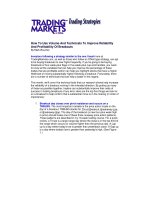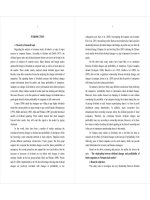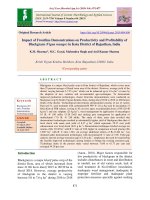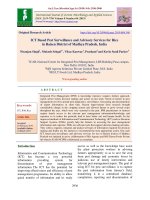Cost, returns and profitability of ber production in Solapur district of Maharashtra, India
Bạn đang xem bản rút gọn của tài liệu. Xem và tải ngay bản đầy đủ của tài liệu tại đây (196.14 KB, 4 trang )
Int.J.Curr.Microbiol.App.Sci (2019) 8(5): 2464-2467
International Journal of Current Microbiology and Applied Sciences
ISSN: 2319-7706 Volume 8 Number 05 (2019)
Journal homepage:
Original Research Article
/>
Cost, Returns and Profitability of Ber Production
in Solapur District of Maharashtra, India
M.S. Bhong, S.R. Nagargoje and R.D. Shelke*
Department of Agricultural Economics, College of Agriculture, Latur, India
*Corresponding author
ABSTRACT
Keywords
Ber, Cost, Gross
return, Net profit,
B:C ratio and
Sampling design
Article Info
Accepted:
20 April 2019
Available Online:
10 May 2019
Investigation was carried out during the year 2017-2018. For present study multistage
sampling design was used in selection of district, tehsils, and village and ber growers. On
the basis of high area under ber crop Pandharpur and Sangola tehsils were selected. From
selected two tehsils 6 villages were selected purposely on the basis of highest area under
ber crop. From each village 8 ber growers were selected. In this way 96 ber growers were
selected for the present study. The information collected with respect to expenditures and
returns were analyzed in tabular form by using cost concept like Cost –A, Cost- B and
Cost – C. Data pertain to the year 2017-2018 The result revealed that Cost – A was Rs.
68694.32 in which share of Cost –B was Rs. 138245.96 while that of Cost – C was Rs.
163719.91. Gross return was found to be Rs. 316217.19 and net profit was Rs. 152497.28.
The B:C ratio was 1.74.
Introduction
Ber is native of India. It is believed that the
Indo-Malaysia region (South and South-east
Asia) is the centre of both evolution and
distribution of the genus Ziziphus. The major
production area of ber is in the semiarid and
arid parts of the country. It is widely
cultivated in Punjab, Haryana, and
Maharashtra. Eighteen species are found in
the Indian subcontinent from the Himalayas
to Capecamorin and from the Western region
to the Eastern wet tropics. The increase
demand may lead to increase in prices of ber
and farmers may be benefited. The need was
felt to answer some queries such as cost,
returns and profitability. Keeping in view of
the above aspects, the present study was
undertaken. The major production area of ber
is in the semiarid and arid part of the country.
The total area under ber in India during 20172018 reported to be 49 thousand hectors &
production is about 530000 million tonnes.
(Source: Indiastat.com). In Maharashtra area
under ber cultivation is 0.99 thousand hectare
with the production of 12.26 thousand metric
tonnes in 2017-18. (Source: Indiastat.com)
and the Area, Production and Productivity of
Ber in Solapur district is 7461 ha, 37,10,000
Qtl, 50 Qtl/hectors respectively. (Source:
kvkSolapur.org.)
2464
Int.J.Curr.Microbiol.App.Sci (2019) 8(5): 2464-2467
The main objectives of this study to estimate
costs and returns in ber production.
Materials and Methods
Multistage sampling design was adopted for
selection of the district, telsil, village and ber
growers. In first stage, Solapur district was
purposively selected on the basis of highest
area under ber crop. In the second stage,
Pandharpur and Sangola tehsils were selected
on the basis of highest area under ber crop. In
the third stage, 6 villages were selected from
each selected tehsils. In the fourth stage, from
each of the selected villages, 8 ber growers
were randomly selected. In this way 96 ber
growers were selected for the present study.
Data were collected with the help of presented
schedule by personal interview method for the
year 2017-2018. Data were converted to per
hectare basis in tabular form; statistical tools
like arithmetic mean, percentage and ratio
were used for accounting the cost and returns
in ber production.
The cost concept like Cost –A, Cost –B, and
Cost –C were used for cost evaluation and to
estimate profitability in ber production. Cost A include the item namely, hired human
labour, bullock labour, machine labour,
manure, fertilizer, plant protection, irrigation,
land revenue, incidental charges, interest on
working capital and depreciation on assets.
Cost-B comprises of the cost-A plus
Amortized establishment cost, rental value of
land and interest on fixed capital. Cost-C
includes the cost-B plus family labour cost.
The terms and concepts used in present study
were as fallows. Interest on working capital
included by charging interest at the rate of 13
per cent items of expenditure as hired human
labour, bullock labour, machine labour, seed,
fertilizers, manures, plant protection, land
revenue an incidental charges for crop
duration. Depreciation is the decrease in the
value of asset and 10 per cent on the present
value at the beginning of the year of farm
implements and machinery was taken and
only the proportionate charges were taken for
the estimate as 1/6th the value of gross
produce that is value of main product plus
value of by product minus land revenue.
Interest on fixed capital by charging interest
at the rate of 11 per cent on investment on
commonly used assets like wooden
implements, iron implements which were
distributed on cropped area.
Result and Discussion
Per hectare physical inputs used and
output obtained in ber production
From the Table 1, it is revealed that at the
overall level, the per hectare use of hired
human labour were 40.49 man days. Per
hectare use of family human labour were
56.60 man days. It is observed that, utilization
of bullock labour per hectare were 2.97 pair
days. On the contrary, machine labour was
used as 16.42 hours on the ber farm. On an
average utilization of manures per hectare
was found to be 55.22quintals. Average use of
nitrogen, phosphorus and potash fertilizer was
110.48 kg, 55.48 kg and 110 kg per hectare at
overall level, respectively.
Per hectare annual cost of ber cultivation
Per hectare cost of cultivation of ber was
studied and depicted in Table 2. The per
hectare cost of cultivation was Rs. 154772.67
in which Cost-A consist (38.01 %) and CostB (83.54 %) i.e. Rs. 58839.21 and Rs.
129298.72 respectively. Expenditure on rental
value of land ranks first Rs.52677.86 i.e.
(34.03 %).
2465
Int.J.Curr.Microbiol.App.Sci (2019) 8(5): 2464-2467
Table.1 Per hectare physical inputs in ber production on the sample farm
Sr.No.
1
2
3
4
5
6
7
Particulars
INPUTS
Hired Labour
Bullock Labour
Machine Labour
Manure
Fertilizers
Nitrogen
Phosphorous
potassium
Family Labour
OUTPUT
Main produce
Unit
Quantity
Man day
Pair day
Hour
Qtl
Kg
Man day
qtl
40.49
2.97
16.42
55.22
110.48
55.47
110
56.60
221.73
Table.2 Per hectare annual cost of ber cultivation
Sr.No
1
Particular
Hired human labour
2
3
4
5
Bullock Pair
Machine labour
Manure
Fertilizers
Nitrogen
Phosphorus
Potassium
Irrigation
Plant protection charges
Incidental Charges
Repairs
Interest on working capital @13 %
Depreciation on capital assets @ 10 %
Land revenue and other taxes
Cost -A (
)
Amortized establishment cost
Rental value of land
Interest on fixed capital @ 11 %
Cost-B (
Family labour (man days)
Cost –C (
6
7
8
9
10
11
12
13
14
15
16
17
18
19
2466
Quantity
40.49
Amount (Rs./ha)
18010.41
Per cent
11.63
2.97
16.42
55.22
2079.00
6568.00
11045.37
1.34
4.24
7.13
110.48
55.47
55.74
1436.24
1385.06
1053.93
1500.00
2576.38
551.59
450.00
11070.03
987.74
125.46
58839.21
12342.68
52677.86
5438.97
129298.72
25473.95
154772.67
0.92
0.89
0.68
0.96
1.66
0.35
0.29
7.15
0.63
0.08
38.01
7.97
34.03
3.51
83.54
16.45
100
56.60
Int.J.Curr.Microbiol.App.Sci (2019) 8(5): 2464-2467
Table.3 Per hectare costs and returns from ber cultivation (Rs/ha)
Sr.No.
1
2
3
4
5
6
7
8
9
Particular
Gross returns
Cost-A
Cost-B
Cost-C
Farm business income (Gross return minus cost-A)
Family labour income (Gross return minus cost-B)
Net profit (Gross return minus cost-C)
Output-Input ratio
Per quintal cost of production
Next item of expenditure is family labour
accounted Rs.25473.95 (16.45 %), hired human
labour Rs.18010.41 (11.63 %), Amortized
establishment cost 11559.77 (7.05 %), interest
on working capital Rs.11070.03(7.15 %),
Manure 11045.37 (7.13 %), machine labour
accounted Rs. 6568.00 (4.24 %), interest on
fixed capital Rs.5438.97 (3.51 %), fertilizer i.e.
Rs.3875.23 (2.49 %), plant protection
accounted Rs.2576.38 (1.66 %), irrigation
charges Rs.1500 (0.96 %), bullock labour
Rs.2079 (1.34 %), depreciation on farm assets
Rs.987.74 (0.63 %), repairs Rs.450.00 (0.29 %),
incidental charges Rs.551.59 (0.35 %), and land
revenue and other taxes Rs. 125.46 (0.08 %). As
the size of holding increases family labour
shows decreasing trend.
From table 3, it was observed that the gross
return was Rs. 316217.19. It was clear that per
hectare farm business income, family labour
income and net profit was Rs.257377.98, Rs.
186918.47 and Rs. 161444.59 respectively in
ber garden. The Output-Input ratio was higher
as 2.04 in ber orchard. Per quintal cost of
production was Rs.698.02.
It is concluded that output- input ratio of ber
was 1.74 which showed that ber fruit was found
to be profitable venture in Solapur district.
How to cite this article:
Ber
316217.19
58839.21
129298.72
154772.6
257377.98
186918.47
161444.59
2.04
698.02
References
Baksh, K., Ishtiaq, H. and Muhammad, S.A.
(2006) Profitability and Cost in Growing
Mango Orchard. Journal of Agriculture
and Social Sciences, 2(1):46-50.
Rajashekar and Kumar, D. (2017) Cost and
return of ginger in Bidar district of
Karnataka an economic analysis. Journal
of Pharmacognosy and Phytochemist,
6(5):472-475.
Shennewad, B.A. and Shelke, R.D. (2008)
Costs and returns in papaya production in
Marathwada region of Maharashtra state.
International Journal of Commerce and
Business Management, 5(2):55-58.
Surwase, R.V., Kshirsagar, P.J., Talathi, J.M.
and Gore, S.T. (2015) Costs, returns and
profitability of sapota in Thane district.
International Research Journal of
Agricultural Economics and Statistics,
6(1):96-99.
Thorat, M.V. and Shelke, R.D. (2012)
Economics of Ber Production in Beed
District of Maharashtra. International
Journal of Commerce and Business
Management, 5(2): 207-209.
Bhong, M.S., S.R. Nagargoje and Shelke, R.D. 2019. Cost, Returns and Profitability of Ber
Production in Solapur District of Maharashtra. Int.J.Curr.Microbiol.App.Sci. 8(05): 2464-2467. doi:
/>
2467









